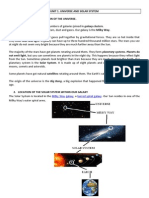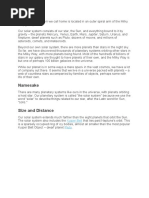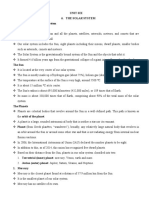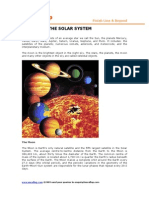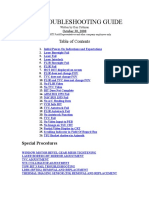The Solar System: Mercury To Neptune
The Solar System: Mercury To Neptune
Uploaded by
Costea IulianaCopyright:
Available Formats
The Solar System: Mercury To Neptune
The Solar System: Mercury To Neptune
Uploaded by
Costea IulianaOriginal Description:
Original Title
Copyright
Available Formats
Share this document
Did you find this document useful?
Is this content inappropriate?
Copyright:
Available Formats
The Solar System: Mercury To Neptune
The Solar System: Mercury To Neptune
Uploaded by
Costea IulianaCopyright:
Available Formats
The solar system
The universe contains over 100 billion galaxies. A galaxy is a group of billions of stars.
Our own galaxy is called the Milky Way, and it contains about 300 billion stars
(300,000,000,000) and one of these is our Sun.
Planets and other objects go round the Sun, and these make up the solar system, with
the Sun at the centre. The solar system contains different types of objects including:
a star - the Sun
planets, which go around the Sun
satellites, which go around planets
smaller objects such as asteroids and comets
The planets in order from the Sun
Mercury to Neptune
There are eight planets in the solar system. Starting with Mercury, which is the closest
to the Sun, the planets are:
Mercury
Venus
Earth
Mars
Jupiter
Saturn
Uranus
Neptune
If you can't remember the correct order, try this sentence, or make one up of your own:
My Very Easy Method Just Speeds Up Naming
Pluto and the dwarf planets
Scientists have discovered other objects orbiting the Sun. These
includecomets, asteroids and dwarf planets, like Pluto and Eris.
Pluto used to be considered the ninth planet in our solar system. But in 2006 scientists
renamed it as a dwarf planet. So now we have 8 planets in the solar system.
Gravitational forces
All objects are attracted towards each other by a force called gravity. Gravity only
becomes noticeable when there is a really massive object like a star, planet or moon. You
can find out more about gravity in the Revision Bite called Forces.
Gravity and the solar system
Gravitational forces between the Sun and planets keep the planets in orbitaround the
Sun. Without these forces, the planets would fly off into deep space.
Their orbits are slightly squashed circles called ellipses. Diagrams often show the orbits
as very squashed, but this is just to get a sense of perspective and to fit the diagrams
onto the page.
The planets furthest out are also the coldest because they receive the least heat energy
from the Sun.
Satellites
Artificial satellites
Artificial satellites are built by people and launched by rockets into space, where they
orbit around the Earth. These are some of the things that artificial satellites are used for:
communications, including broadcasting television programmes and relaying
telephone calls
Global Positioning System (GPS) and Galileo satellites for navigation
collecting information to help with weather forecasts
scientific surveys of the Earth's surface
map making
spying
http://www.bbc.co.uk/bitesize/ks3/science/environment_earth_universe/astronom
y_space/activity/
You might also like
- Astronomy 4 Homework Assignment 1Document5 pagesAstronomy 4 Homework Assignment 1William R Stone80% (5)
- UNIT 1. Universe and Solar SystemDocument7 pagesUNIT 1. Universe and Solar SystemtissusesNo ratings yet
- 1__Year_8_Sample_-_Information_Textd17v2Document1 page1__Year_8_Sample_-_Information_Textd17v2farida.ahmed.ateiaNo ratings yet
- Our Solar SystemDocument50 pagesOur Solar SystemKashish GuptaNo ratings yet
- Igcse (9 - 1) Physics Unit 8: AstrophysicsDocument17 pagesIgcse (9 - 1) Physics Unit 8: AstrophysicsDraugerPlayzNo ratings yet
- Solar SystemDocument8 pagesSolar SystemEzra SilvestreNo ratings yet
- Nakshatras 20-12-15Document36 pagesNakshatras 20-12-15shunmugathasonNo ratings yet
- The Solar SystemDocument28 pagesThe Solar SystemkiluNo ratings yet
- The Solar SystemDocument11 pagesThe Solar SystemDaniela StaciNo ratings yet
- Reading Planets 7th The-Solar-System-Reading-Material-Grades-6-8Document5 pagesReading Planets 7th The-Solar-System-Reading-Material-Grades-6-8angelica.murciahNo ratings yet
- Solar SystemDocument12 pagesSolar SystemDeepak Lohar DLNo ratings yet
- Space: HandbookDocument22 pagesSpace: HandbookIftikhar Ahmed100% (1)
- GeographyDocument10 pagesGeographyhurairaNo ratings yet
- 14 Fun Facts About the Solar System: A 15-Minute Book: 15-Minute Books, #135From Everand14 Fun Facts About the Solar System: A 15-Minute Book: 15-Minute Books, #135Rating: 5 out of 5 stars5/5 (1)
- Solar SystemDocument3 pagesSolar Systemisaackmahlangu1No ratings yet
- Astro - Unit 3Document36 pagesAstro - Unit 3kcameppadi123No ratings yet
- Elementary AstronomyDocument7 pagesElementary AstronomyJoseph ManaseNo ratings yet
- Solar System in Depth 1Document4 pagesSolar System in Depth 1Vinayak rashinkarNo ratings yet
- Skip To Main ContentDocument17 pagesSkip To Main ContentStéphane DoueuNo ratings yet
- J6soGbtTp8Document5 pagesJ6soGbtTp8enochmaaNo ratings yet
- We and Our World 6Document55 pagesWe and Our World 6Dav GuaNo ratings yet
- Lesson Notes 2 Earth and SpaceDocument18 pagesLesson Notes 2 Earth and SpaceUzma Waqas/Education/HONo ratings yet
- Module 2Document72 pagesModule 2AshleyNo ratings yet
- 14 Fun Facts About the Solar System: Educational VersionFrom Everand14 Fun Facts About the Solar System: Educational VersionRating: 5 out of 5 stars5/5 (1)
- Presentation1 HHW Celestial BodiesDocument13 pagesPresentation1 HHW Celestial BodiesRiya jainNo ratings yet
- List of planets Solar System, Dwarf Planets, Moons BritannicaDocument1 pageList of planets Solar System, Dwarf Planets, Moons Britannicaoparindeprecious34No ratings yet
- Earth & UniverseDocument19 pagesEarth & UniverseCalvinRodgers100% (1)
- Planets (1) - 1Document4 pagesPlanets (1) - 1safakhader204No ratings yet
- Chapter 1 Topic 1 The Solar System 1Document4 pagesChapter 1 Topic 1 The Solar System 1zadibbinalam02No ratings yet
- SOLAR SYSTEMDocument9 pagesSOLAR SYSTEMynami3455No ratings yet
- (DALIDA) Formation of The Solar SystemDocument3 pages(DALIDA) Formation of The Solar SystemkathleenmaerdalidaNo ratings yet
- Our Solar SystemDocument3 pagesOur Solar Systembarangayorence2024No ratings yet
- Report Text SolarsystemDocument5 pagesReport Text SolarsystemFaradilah RiskaNo ratings yet
- Unit Six 6. The Solar System 6.1. Family of The Solar System The Solar SystemDocument10 pagesUnit Six 6. The Solar System 6.1. Family of The Solar System The Solar Systemtsehay asratNo ratings yet
- What is The Solar System? Astronomy Book for Kids | Children's Astronomy BooksFrom EverandWhat is The Solar System? Astronomy Book for Kids | Children's Astronomy BooksNo ratings yet
- Solar System Facts - A Guide To Things Orbiting Our SunDocument12 pagesSolar System Facts - A Guide To Things Orbiting Our SunSrushti SawantNo ratings yet
- 10 Facst About Solar SystemDocument3 pages10 Facst About Solar SystemNizza Claire BusaNo ratings yet
- Earth and The Solar SystemDocument21 pagesEarth and The Solar SystemRija FatimaNo ratings yet
- Phy Topc 7 F4Document9 pagesPhy Topc 7 F4Kandrossy GlassNo ratings yet
- Astro PhysicsDocument31 pagesAstro Physicsazoticdenis42310No ratings yet
- 1 - Lesson 1 - An OverviewDocument4 pages1 - Lesson 1 - An Overviewapi-374462323No ratings yet
- 6.1 Earth and The Solar System-HandoutDocument4 pages6.1 Earth and The Solar System-HandoutMohammad Wajeeh MohsinNo ratings yet
- L-7 Solar SystemDocument5 pagesL-7 Solar SystemKhushi KotwaniNo ratings yet
- 101 Facts… Solar System: 101 Space Facts for Kids, #4From Everand101 Facts… Solar System: 101 Space Facts for Kids, #4Rating: 4.5 out of 5 stars4.5/5 (4)
- Solar System - by Diffit (Printable)Document4 pagesSolar System - by Diffit (Printable)Linda HongNo ratings yet
- 790022quiz Booklet-1 Complete - Basic Definitions & Space KnowledgeDocument13 pages790022quiz Booklet-1 Complete - Basic Definitions & Space KnowledgeAiden An CamreNo ratings yet
- Physics Presentation Abdallah Mnana & Yussef Mzee TextDocument2 pagesPhysics Presentation Abdallah Mnana & Yussef Mzee TextAbdallah MnanaNo ratings yet
- The Solar SystemDocument4 pagesThe Solar SystemClaudine Manuel LibunaoNo ratings yet
- Earth and Life Science OutlineDocument6 pagesEarth and Life Science OutlineYveth CruzNo ratings yet
- PrssDocument11 pagesPrssPrawin SanjaiNo ratings yet
- Planets Pt. 10Document5 pagesPlanets Pt. 10jpbalganion.fo2No ratings yet
- Solar SystemDocument1 pageSolar SystemFelix DawnNo ratings yet
- The Earth in The Solar System Class 6 Notes Social Science Geography Chapter 1-Converted1Document6 pagesThe Earth in The Solar System Class 6 Notes Social Science Geography Chapter 1-Converted1SampathkumarNo ratings yet
- The Earth in The Solar SystemDocument11 pagesThe Earth in The Solar System081286sgopiNo ratings yet
- 8 Science Stars&SolarSystemDocument7 pages8 Science Stars&SolarSystemAjay AnandNo ratings yet
- Solar SystemDocument47 pagesSolar SystemHarvey Villalobos100% (1)
- NCERT 6th STD GeographyDocument68 pagesNCERT 6th STD GeographyPhaniDeepNo ratings yet
- Review Statistik (Simple Linear and Correlation)Document21 pagesReview Statistik (Simple Linear and Correlation)Firdayanti SaudinNo ratings yet
- Flame Detector: Ansi Device NumberDocument4 pagesFlame Detector: Ansi Device NumberIlham HendratamaNo ratings yet
- 1800 LTE Onfiguration Guide-E2E PW Ver1.4Document68 pages1800 LTE Onfiguration Guide-E2E PW Ver1.4xpic-dogNo ratings yet
- Introduction To Superstrings Theory PDFDocument19 pagesIntroduction To Superstrings Theory PDFpasha khanNo ratings yet
- Earthquake Resistant Design of Structurespdf - Compress PDFDocument660 pagesEarthquake Resistant Design of Structurespdf - Compress PDFJEAN THIMOTY CHAMPI MEDINA100% (2)
- Nts Troubleshooting Guide 1Document21 pagesNts Troubleshooting Guide 1David RevelsNo ratings yet
- Modbus TCPDocument16 pagesModbus TCPJorge ValdiviaNo ratings yet
- Quiz 1: Solutions: 6.045J/18.400J: Automata, Computability and ComplexityDocument9 pagesQuiz 1: Solutions: 6.045J/18.400J: Automata, Computability and ComplexityAAtroxNo ratings yet
- Introduction To UnityDocument37 pagesIntroduction To Unity10POWERGOD Del GODSTEAMNo ratings yet
- Partial Transmit Sequence Based Low Complexity Receiver For Multi-User STBC Mc-Cdma SystemDocument63 pagesPartial Transmit Sequence Based Low Complexity Receiver For Multi-User STBC Mc-Cdma SystemlakshmipoNo ratings yet
- Further Mathematics: Syllabus Special 25 MorningDocument5 pagesFurther Mathematics: Syllabus Special 25 MorningRong Tin Nationalist AllianceNo ratings yet
- Community Dental Health Flashcards - QuizletDocument20 pagesCommunity Dental Health Flashcards - QuizletRMNo ratings yet
- Physics of Power Dissipation in CMOS FET DevicesDocument70 pagesPhysics of Power Dissipation in CMOS FET DevicesPunith Gowda M BNo ratings yet
- Numerical Magnetohydrodynamics in AstrophysicsDocument27 pagesNumerical Magnetohydrodynamics in AstrophysicsNikhil Arun KumarNo ratings yet
- Ballistic CoefficientDocument6 pagesBallistic CoefficientMB-RPNo ratings yet
- PEC 2019 Design GuidelinesDocument9 pagesPEC 2019 Design GuidelinesHendrix LevaNo ratings yet
- Grade 7 Solving Percent ProblemsDocument9 pagesGrade 7 Solving Percent ProblemskautiNo ratings yet
- Drawing1 Model PDFDocument1 pageDrawing1 Model PDFArshad AliNo ratings yet
- AlstomDocument68 pagesAlstomMauricio AguilonNo ratings yet
- DLL MATH 2ND Quarter-Week 8Document5 pagesDLL MATH 2ND Quarter-Week 8ۦۦ ۦۦ100% (2)
- Inverse Trigo Formulae-Converted1Document2 pagesInverse Trigo Formulae-Converted1Hirishik Sarkar 10ANo ratings yet
- Construction Management and Law 2 PDFDocument2 pagesConstruction Management and Law 2 PDFENGINEERING FORUMNo ratings yet
- Station 1: Modeling Equations and Word ProblemsDocument7 pagesStation 1: Modeling Equations and Word ProblemsMajid KhanNo ratings yet
- Octave For Red Hat Linux Systems: Unspecific RHDocument2 pagesOctave For Red Hat Linux Systems: Unspecific RHPhoenix Liebe JeffNo ratings yet
- Ib Security Assistant Questions Answers Asked Aaa03415Document19 pagesIb Security Assistant Questions Answers Asked Aaa03415Nitin DangiNo ratings yet
- 1.3.1.3 Lab - Mapping The InternetDocument13 pages1.3.1.3 Lab - Mapping The InternetMuwien0% (2)
- Why do people purchase from online travel agencies (OTAs)_ A consumption values perspectiveDocument11 pagesWhy do people purchase from online travel agencies (OTAs)_ A consumption values perspectiveAnkush DhimanNo ratings yet
- Complete Download Data Structures Algorithms in Go 1st Edition Hemant Jain PDF All ChaptersDocument62 pagesComplete Download Data Structures Algorithms in Go 1st Edition Hemant Jain PDF All Chaptersmratinbardou100% (4)
- Pneumatic Vs Electric Cost CalculatorDocument7 pagesPneumatic Vs Electric Cost CalculatorCazacu AndreiNo ratings yet
- Mark Scheme (Results) October 2016: Pearson Edexcel International GCE in Chemistry (WPH02) Paper 1Document15 pagesMark Scheme (Results) October 2016: Pearson Edexcel International GCE in Chemistry (WPH02) Paper 1Amar Ibna IslamNo ratings yet

